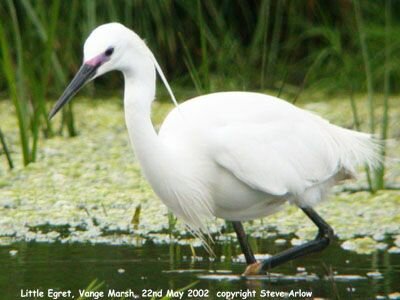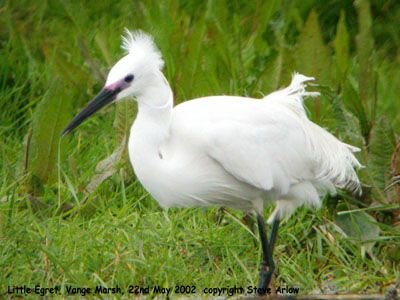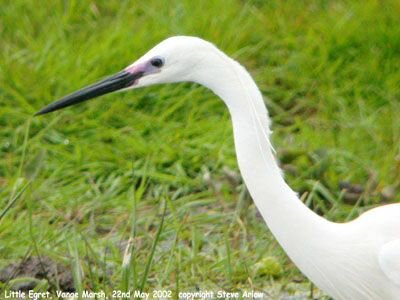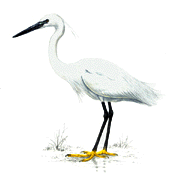 |
Big Little Egret Counts:
2007
2006
2005
2004
2003
The History of the Little Egret
The Little Egret is the latest addition to the British breeding bird fauna, it is a small white heron-like bird. The history of egrets, including the Little Egret is inextricably linked to that of the RSPB. The large scale killing and population decline of these birds by the plume trade in the 19th century lead to the formation of the RSPB in 1889.
Description
The Little egret is a miniature heron, and at around 60cm stands at about two thirds of the height of a Grey heron. Its feathering is pure white, decorated with elongated lacy plumes on the body. The bill is black, and a bare green or blue-grey area leads from it to a bright yellow eye. The long black legs contrast with the yellow feet. In the breeding season the birds grow more and longer plumes on the chest and upperparts, and two long crest feathers that hang down the back of the neck. For a brief period at the start of the breeding season, the feet and the bare part of the face turn red.
The Fall and Rise of the Little Egret
The Little Egret is widely distributed in Europe, Africa, Asia and Australia. It was almost wiped out in Europe by the plume trade in the 19th and early 20th centuries. The end of the plumage trade during the First World War allowed the population to increase slowly, aided more recently by the total protection of the species in most European countries. It re-established itself in the Northern Mediterranean in the early 1930s. It is not known if this was by recolonisation from Africa or population increase by the surviving local birds. In time, it spread northwards and was recorded nesting in Brittany in 1960. There was only one colony in Brittany until the 1980s when the species became well established throughout the region. The post-breeding dispersal of mainly young egrets is in a north-westerly direction. As the birds over-winter for the first time in new areas, many stay over to breed. This has greatly assisted their spread across Franc and eventually into Britain and Ireland.
Little Egrets in Britain
There had been a handful of reports of Little Egrets in Southern England every year since the 1940s. Then in 1989, coincidentally the centenary year of the RSPB. A major influx of the birds occurred, thought to have originated from the North Brittany colonies. At least 120 individuals were recorded that year, mostly on the south coast between West Sussex and Cornwall. Since the, Little Egrets have been present all year round in Britain. Highest numbers are found during August to October during the now annual influx of Continental birds, while the lowest numbers are recorded during the breeding season in Mat to June.
The number of egrets in Britain increased steadily during the 1990s, This culminated in the first recorded breeding in 1996 when a pair on Brownsea Island in Poole harbour, Dorset, successfully raised young. The Brownsea colony steadily grew in subsequent years, and has now stabilised at around 42-45 pairs.
Since 1996 egrets have extended their nesting range every year. In 1997 they nested in Cornwall and on the south coast of Ireland. In 2001 there were successful nests in Wales and Cheshire. The first nesting in Essex was recorded in 2000, and in Suffolk and Norfolk two years later. So far, only two colonies hold more than a handful of pairs. Apart from Brownsea Island, the only other major nesting colony is at the RSPB Northward Hill reserve in Kent. From the two pairs that nested there in 2000, numbers quickly built to 30 pairs in 2003.
Nesting
In the UK, Little Egrets nest among Grey herons. The nest is a typical heron nest a platform of sticks high in a tree or a bush. Even though egrets nest colonially, they do defend the immediate area around the nest. The female lays a clutch of 2-6 eggs, one a day, and starts to incubate as the first egg is laid. The chicks hatch over several days about three weeks later. The chicks start to climb on branches around the nest before they fledge at four weeks old.. They will spend a further month in their parents' care while they learn to feed themselves and perfect their flying skills.
It is only possible to see nesting Little Egrets at Northward Hill and Brownsea Island, and even then only from a distance. Little Egrets are easily disturbed at nesting grounds, and so people should not go in search of nests. At the two main colonies, special provisions have been made to allow viewing without disturbing the birds.
Habitat and Food
The Little Egret prefers margins of water, and is rarely found far from water. In the UK, it is mainly a coastal species, inhabiting intertidal mudflats and coastal marshes and lagoons. However, increasing numbers of birds are being found inland, in and around wetland areas that provide suitable food. They feed mainly on small fish, but also take terrestrial and aquatic insects and their larvae, small amphibians, crustaceans, worms, snails etc depending on season availability. They prefer prey around 4cm long, but have been known to take items up to 15cm.
How Many Egrets are There?
Little Egret breeding and non-breeding populations are increasing every year and the peak numbers that we get in late summer and autumn are dependant on the influx of Continental birds. Consequently, any estimate of numbers is likely to be out of date even before it is published. In 2001, around 100 pairs bred in 18 localities in the UK. In 2002, the late summer/autumn peak is likely to have approached 3,000 birds.
Future of the Little Egret
The northward spread of the Little Egret and its colonisation of the British iIsles have no doubt been aided by milder winters, which the birds survive better. Severe winters are thought to be the main factor determining the range and survival of the species. Extended freezing conditions and ice cover can wipe out a high percentage of the population. The continued survival and spread of the Little Egret in the UK will be dependant on future winter conditions which will also be limiting its colonisation to the north and east.
Legal Protection
The Little Egret is fully protected under the Wildlife and Countryside Act 1981, which makes it an offence to kill, injure or take an egret, or to take, damage or destroy an active nest or its contents.
Over the last few years we have become aware of an increasing number of the beautiful Little Egrets that can now be seen all along our coastline, no more than ten years ago the Little Egret was an extremely rare bird in the area. Little Egrets were once persecuted in their millions across their range in large numbers by the Victorians for their decorative crest feathers. The feathers became highly fashionable and could only be taken by killing the birds. By 1902, the trade in wild bird feathers was reaching huge proportions, as exampled by official trade figures of auctions at the London Commercial Sales Rooms that year: Sold were 1,608 packages of .... herons' plumes. From almost 200,000 herons killed at their nests.
The Little Egret holds great affection for the RSPB as, in 1891, The Didsbury group and ladies attending Mrs Phillips' Fur and Feather meetings at her house in Croydon amalgamate to become the Society for the Protection of Birds in 1889. One of the first reports produced in the October of that year was entitled: ' The Osprey, or Egrets and Aigrettes. Leaflet no 1, the Destruction of Ornamental Plumaged Birds'.
The thrill of watching the present range expansion and return of the Egrets with birds being easily observed from Two Tree Island to Wakering is very exciting.
Little Egrets breed across southern Europe from Iberia to Greece and Turkey, and north to the northern coasts of the Black Sea. It is only during the last twenty years that this bird has undergone a considerable expansion of its range and now breeds in northern France and the Netherlands. Most birds in Europe migrate to sub-Saharan Africa but others winter around the Mediterranean. Post-breeding dispersal takes many birds north of their main breeding range in late summer and autumn. In recent years it has appeared much more frequently around our shores.
Peak numbers at our roost sites tend to occur in late August and early September, then some birds disperse to smaller sites as winter progresses. During cold weather Little Egrets are often seen inland, particularly along creeks and rivers.
|
||
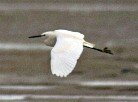 |
Little Egret Counts
In October 2003 the South East Essex RSPB Local Group became increasingly interested in the actual numbers of Little Egret that were now in the area. With this in mind it was decided to co-ordinate a count that would encompass as many of the evening Essex and Kent Little Egret roosts as possible. We asked for volunteers via our website and we are indebted to all of the people that freely gave up their time for us. Since then, we have conducted the count each year. The results of these are reproduced below.
The Big Little Egret Count 2007
Weekend of the 08th - 09th September.
| Foulness Island and Environs | 107 | River trip around Foulness, Potton and Wallasea 09-30 - 15.30. |
| Southchurch Park East, Essex | 1 | 08.50 Bob Dobinson. |
| Canvey Point. Essex | 4 | T Morgan. |
| East Tilbury, Essex | 2 | 08.30 - 10.30. David Jobbins. |
| Wallasea Wetlands, Essex | 63 | 12.00 Nick Green, Jeff Delve. |
| Two Tree Island, Essex | 118 | Iris Cotgrove. Dusk roost counted by Mark and Marilyn Bridges also 70 birds. |
| St Oysth, Essex | 155 | 07/09/07. Siomn Cox. |
| Abberton Reservoir | 83 | 08/09/07. John Thorogood. |
| Stoke Fleet, North Kent | 60 | 08/09/07. This roost is steadily disintegrating due to the presence of several Marsh Harriers, low flying microlites & noisy flocks of Rooks & Jackdaws, also roosting. Trevor and Janet Bowley. |
| Kingsnorth, North Kent | 374 | The Little Egret have returned to this area after two years absence. Trevor and Janet Bowley. |
| North Quarry, North Kent | 55 | 10/09/07. An average count for this consistent roost. Trevor and Janet Bowley. |
| Northward Hill, North Kent | 60 | 11/09/07. This roost is usually deserted during August! Trevor and Janet Bowley. |
| Total: | 1082 |
Notes:
The copse at Dagnam saltings has been struck down with Dutch Elm disease, so most of the dead trees have been blown down and the remainder are leafless, no longer a roost for Little Egret. A much improved situation in North Kent this year, helped by an increase to at least 75 pairs of Little Egret breeding at Northward Hill. Note that the counts above are not a consistent feature in the Thames & Medway. The only regular day roost is at the Yantlet, where a roost of 35 - 40 Little Egret has been present during the last two weeks. However, on Sunday 09/09/2007, the roost had dispersed due to overnight campers and a motorised dingy at the saltmarsh. No doubt the roost was not far away, probably on Grain marshes, adjacent to the Yantlet Creek. Elsewhere in the Thames & Medway, most Little Egret continue feeding in the many fleet systems and around Cliffe Pools. On the Thames, the large numbers in the Medway are dispersed among the numerous islands, generally obscured from view. Trevor Bowley.
Appendix:
A great many thanks to Gary Dunn for giving up his day to captain us around the foulness creeks. As usual, we are indebted to all of our observers that gave up their time for the count.
The Big Little Egret Count 2006
Weekend of the 02nd - 03rd September.
| Foulness Island, Essex | 106 | 02/09 Chris Lewis |
| Two Tree Island, Essex | 75 | Roost count at 19:40. EWT Chief Warden, Mark Bridges. |
| Benfleet Creek, Essex | ||
| Abberton Reservoir, Essex | 141 | Mark Nowers, Warden, Wolves Wood Reserves |
| St Osyth, Essex | 138 | 10/09 Simon Cox |
| Lofts Farm, Heybridge, Essex | ||
| Stour Estuary, Essex | 1 | Mark Nowers, Warden, Wolves Wood Reserves |
| Abbots Hall, Essex | ||
| Dagnam Copse, Kent | 5 | 02/09 JS & TE Bowley. |
| North Quarry, Cliffe, Thames, Kent | 44 | 02/09 J.C.Martin & M.J.Orchard. |
| Stoke Fleet, North Medway, Kent | 297 | 02/09 T.N.Hodge. |
| Northward Hill, Kent | 24 | 04/09 S & TE Bowley. |
| Graveney, South Swale, Kent | 44 | 31/08 S & TE Bowley. |
| Total: | 737 |
Notes:
The weather for our 2006 count left a lot to be desired with squally rain showers and high winds.
Appendix:
1 Kingsnorth, Kent had no roosting birds.
2. From Mark Nowers: The Stour is clearly not an evening roost for Little Egrets. They favour a tree at high tide on the reserve at Deep Fleet, but at dusk it is a different kettle of fish. Only 1 bird roosted there. There were no other roosting birds at favoured spots on the estuary. However, I strongly suspect that our birds go round to the Orwell, as there were 68 roosting at Loompit Lakes on the north shore of the Orwell.
3. From Chris Lewis: For comparison there were 142 Little Egrets in the Foulness area on the August WeBS count and 221 in South Essex as a whole.
The Big Little Egret Count 2005
Weekend of the 10th - 11th September.
| Foulness Island, Essex |
140 | Chris Lewis, Henry Hume. |
| Two Tree Island, Essex |
94 | At high tide roost between 17:05 and 17:40. Web Author. |
| Benfleet Creek, Essex | 4 | Near Benfleet Station. John Wright. |
| Abberton Reservoir, Essex | 101 | Good count at Abberton at dusk on Saturday. Mark Nowers. |
| St Osyth, Essex | 165 | Simon Cox. |
| Lofts Farm, Heybridge, Essex | 134 | Russell Neave. |
| Stour Estuary, Essex | 55 | Deep Fleet - 30, Erwarton Bay (Suffolk side) - 21, Cattawade - 4. Mark Nowers. |
| Abbots Hall, Essex | 42 | On the 12th. Nick Ransdale |
| Dagnam Saltings copse, Kent | 100 | Trevor Bowley. |
| North Quarry, Cliffe, Thames, Kent | 94 | On the 11/09. Trevor Bowley. |
| Stoke Fleet, North Medway. | 248 | On the 07/09. Trevor Bowley. |
| Total: | 1,177 |
Notes:
We have decided to include the new location of Stoke Fleet, North Medway even though this was counted on the 07th September as a large number of these birds are probably Kent birds. Unfortunately Northward Hill was not counted on this occasion.
Appendix:
Kent News
Stoke Fleet - a new roost from July this year, replacing Kingsnorth. Dagnam Copse - thick mist over the Thames on Sat. evening meant that we could not see where the LE. were coming from but we suspect most arrived from Essex. North Quarry, Thames - many of these must arrive from Essex, presumably west of Cliffe. Kingsnorth - This former large roost on the North Medway was abandoned this year in favour of Stoke Fleet, but half the population are missing, so we are about 200 LE down this season. Northward Hill - 57 pairs bred in the Heronry in 2005, but the LE. soon dispersed from here & the roost was no longer in use by September. Trevor Bowley.
Also counted on different dates:
Canvey Point 11th September:
61 Little Egret (flying to Canvey Pt. at dawn from Allhallows roost ). Jeff Saward (SOG).
Two Tree Island 08th September:
40 Little Egret on high tide roost.
Two Tree Island 04th September:
48 Little Egret on high tide roost.
Other reports from around the country:
2 Little Egret seen today at WWT Slimbridge. These were on mud flats lining the Severn estuary. A.G.McDowell.
I saw one today at 4.15 pm flying over the river Ebble at Broad Chalke south west of Salisbury. There are usually one or two there. They roost there during the summer. Last year I saw seven in one tree.
The Big Little Egret Count 2004
The Little Egret count 2004 was held on the evenings of the 4th and 5th of September. The idea of the count last year came rather late to us and we realised that we perhaps missed the peak numbers, this year we had decided that the first weekend of September would be a very good time for the count.
Saturday 04th September 2004
| Foulness Island, Essex | 206 | This number represents a new record for this roost |
| Two Tree Island, Essex | 0 | No Egrets reported at the evening roost. Martin Johnson. There was a hide tide count 16.30 to 17.15 of 36 which we are pretty sure roost in North Kent. |
| Abberton Reservoir, Essex | 120 | Count form Adrian Kettle. |
| St Osyth, Essex (05/09) | 20 | I counted the St Osyth roost on Fri 3/9 as I had other commitments on the Sat & Sun & logged 20 birds. I'd had 88 at the end of July & in past years numbers have risen through to at least September but it sounds as though there are a lot elsewhere so they've obviously had a change of preference this autumn. It has been an amazing increase over the last 5 yrs or so. Simon Cox. |
| Lofts Farm Gravel Pit, Heybridge, nr Maldon, Essex (05/09) | 141 | 4 still on adjacent Chigborough Lakes. Russell Neave |
| North Quarry, Cliffe Pools, Kent | 61 | There were 10 LE. present at HT. initially, & an est. 20 around the pools nearby but a difficult area to get an accurate count of this species. The difference of c. 30 could have arrived from Essex. Janet & Trevor Bowley |
| Dagnam saltings, Kent (south of Two Tree Island) (05/09) | 73 | 73 roosted in the elm - spinney. 50 arrived from Essex. Janet & Trevor Bowley |
| Kingsnorth, North Medway, Kent (counted on 29/08) | 444 | N.B. The other major Thames roost, at Northward Hill, had a nil count of Little Egret on 28/08/2004, so is now not being used. The large Little Egret roost at Kingsnorth, on the north Medway, although it does not attract birds from Essex ( as far as we know ), had a record count of 444 on 29/08, and may attract even more on our next count at mid - Sept. Janet & Trevor Bowley |
| Total: | 1,065 |
The Big Little Egret Count 2003
Saturday 18th October 2003
| Foulness Island, Essex |
132 | This roost has drifted south of where it used to be last year. It isn't until right on the edge of darkness that most of the Egrets start to populate the roost. Web Author. |
| Two Tree Island, Essex |
50 | None actually roosted! All birds flew from roost due to disturbance by fireworks. It is possible that they may have flown to the Kent coast. John Wright, Simon Buckell, Mark and Marilyn Bridges. |
| Abberton Reservoir, Essex |
23 | Adrian Kettle. (Adrian tells us that, during late August, there are regular counts at Abberton of well over 100 birds - this raises the interesting question of where do the majority of these birds go to in the winter. Do they come down to us, travel further south or even migrate in to France and beyond? We will have to wait for a ringing or satellite tracking program to find out the answer to this question - Ed). |
| Loft's Farm, near Heybridge, Essex | 65 | Russell Neave. |
| Tewkes Creek / Canvey Point Roost, Essex |
20 | Typically in the last week or so there have been around 20 birds at the roost. Jeff Saward. |
| Dagnam Saltings copse, Kent | 44 | Trevor Bowley. |
| North Quarry, Cliffe, Thames, Kent | 36 | Trevor Bowley. |
| Kingsnorth, North Medway, Kent | 245 | Trevor Bowley. |
| Total: | 615 |
North Kent Roosts:
The two local roosts which attract Little Egret from Essex were counted. At Dagnam saltings, south of Two tree island, there were no Little Egret in the vicinity at 16.00 hrs. There is not normally a day time high tide roost here since local Little Egret can feed on adjacent marshes at Yantlet & St. Mary's. However, towards dusk 44 Little Egret arrived from Essex to roost overnight at the saltings copse. At the North Quarry, Cliffe Pools, 36 Little Egret arrived to roost at dusk. It is not possible to know where they come from but very few are feeding around the pools at present, so a count at high tide would not be very informative. A flock of 15 dropped in to roost during the count and it is quite likely that they came from Essex. The other major Thames roost, at Northward Hill, is not used by Little Egret from September onwards. The large Little Egret roost on the north Medway does not attract birds from Essex. Our counts for mid - October were completed during the period 18 - 21 / 10 inclusive.
Also counted on different dates:
St Osyth on 5th October (most recent count):
127 Little Egret. Simon and Pat Cox.
In addition, Little Egrets use the Stour Estuary on the Essex/Suffolk border, roosting at Loompit Lake on the Orwell Estuary, in Suffolk recent counts have been around 70 birds.
Additional Little Egret Information
Little Egret (Egretta garzetta)
Eggs: 3-6
Incubation: 21-22 days
Fledging: 40-45 days
Length: 55-65cm
Wingspan: 88-95cm
Weight: 350-550g
Breeding
Little Egrets are wetland birds with a preference for lowland shallow waters, especially along coasts and estuaries. They nest communally, often alongside the nests of other herons and associated wetland species. Colonies are located in reedbeds, wetland scrub and in trees near water, up to a height of 20m. there are two known breeding sites within ten miles of Southend.
Other Sites
The Little Egret can also be found in good numbers along the south coast, and on parts of the east coast. The estuaries of south Devon and Cornwall; Poole Harbour and Chichester Harbour hold some of the largest concentrations and birds can be seen right round to North Norfolk.
Threats
The great irony is that these birds, whose plight provided such an impetus for the formation and success of the RSPB at the end of the 19th Century, should then eventually prosper at the end of the 20th, only to come up against, at least at Northward Hill, a much more modern threat - the proposed airport at Cliffe. Your support for the 'No Airport at Cliffe' campaign finally and hopefully meant that a safe haven was assured for the Egrets here. Another threat to the Little Egret is from of egg thieves and concerns about disturbance whilst they establish each new colony.
Increased management of coastal land (especially the proposed sea wall breaches at Wallasea and the Fleet for example) and the milder winters can only benefit the birds that over-winter with us and we will hopefully see this delicate and beautiful bird increase in numbers.
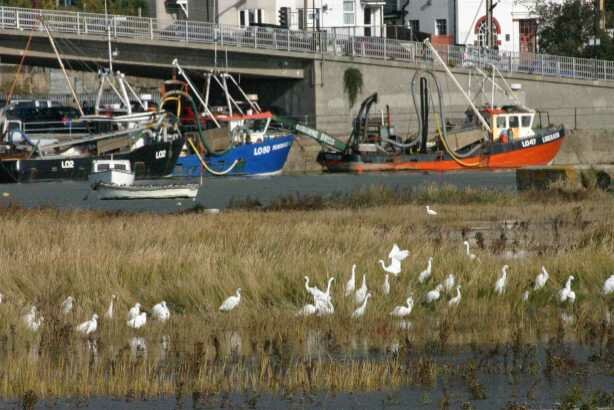 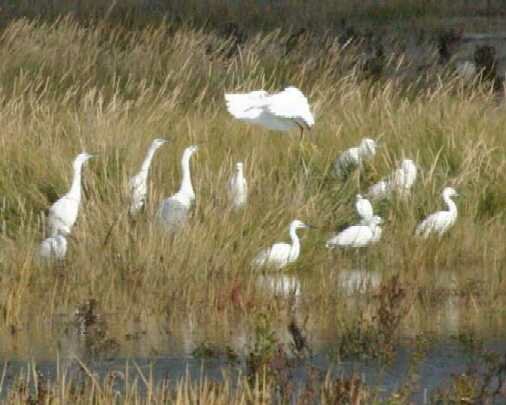 Little Egrets at Leigh on the salt marsh at high tide Photos above by Stephen Anderson 26/10/03. 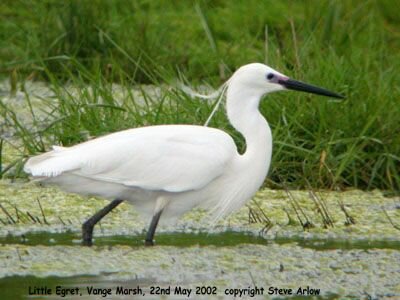 Little Egret at Vange Marsh showing evidence of the prized head feathers
|
Photos above by Steve Arlow
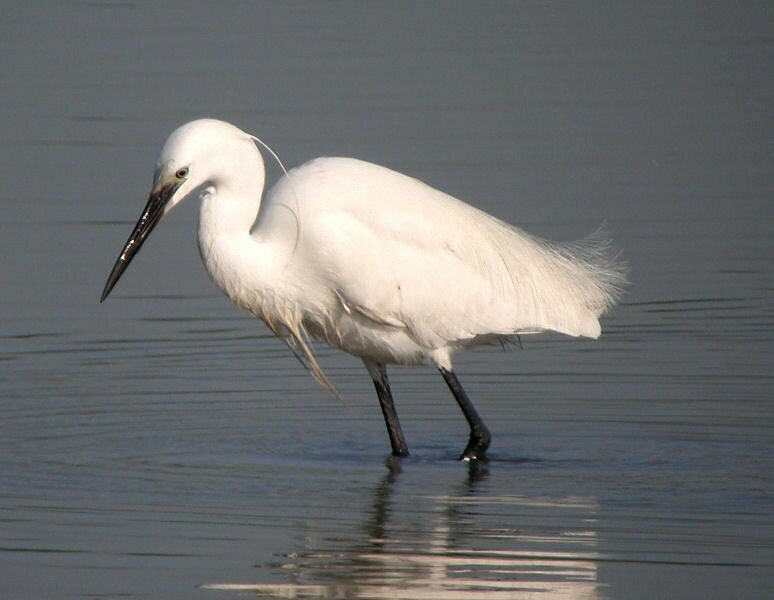
Little Egret on Two Tree Island. Photo by David Lee.
Page last updated:
Web Design Graham Mee. © Copyright of all pages South East Essex RSPB Local Group. All images copyright of owners
The Royal Society for the Protection of Birds. Registered charity no 207076
Please read our cookie, privacy and visitor policy
Translate this page: 





